
How to Increase Patient Engagement
Patient engagement has emerged as a crucial factor in ensuring positive health outcomes and overall satisfaction for both patients and healthcare providers. Traditionally, the patient-doctor relationship has been somewhat passive, with patients relying heavily on healthcare professionals for guidance and information.
However, with the advent of technology, particularly patient engagement apps, there has been a huge shift in more active involvement of patients in their own healthcare journey. In this blog post, we’ll get into the significance of patient engagement apps and explore effective strategies for increasing patient engagement through these innovative platforms.
What is Patient Engagement App?
Patient engagement apps are software applications designed to empower patients by providing them with access to their health information, facilitating communication with healthcare providers, and offering tools for self-management of health conditions. These apps come in various forms, including mobile applications, web portals, and wearable devices, catering to the diverse needs and preferences of patients.
The Importance of Patient Engagement
Engaging patients in their healthcare process is vital for several reasons:
1.Improved Health Outcomes: Actively engaged patients are more likely to adhere to treatment plans, adopt healthier behaviors, and effectively manage chronic conditions, leading to better health outcomes.
2.Enhanced Communication: Patient engagement apps foster seamless communication between patients and healthcare providers, enabling timely exchange of information, clarification of doubts, and proactive management of health concerns.
3.Empowerment and Education: By providing access to relevant health resources, educational materials, and personalized health insights, patient engagement apps empower patients to make informed decisions about their health and well-being.
4.Efficiency and Convenience: These apps streamline administrative tasks, such as appointment scheduling, prescription refills, and access to medical records, thereby saving time for both patients and healthcare providers.
Strategies to Increase Patient Engagement Using Patient Engagement Apps
1.User-Centric Design: To maximize engagement, patient engagement apps should be intuitively designed, with a user-friendly interface and seamless navigation. Incorporating features such as personalized dashboards, push notifications, and interactive tools can enhance the user experience and encourage regular usage.
2.Educational Content: Providing educational content on various health topics, treatment options, and self-care strategies within the app can empower patients with valuable knowledge and insights. Interactive quizzes, videos, and infographics can make learning more engaging and enjoyable.
3.Remote Monitoring and Telemedicine: Integrating remote monitoring devices and telemedicine capabilities into patient engagement apps enables healthcare providers to remotely monitor patients’ vital signs, track their progress, and conduct virtual consultations. This not only enhances access to care but also promotes proactive management of health conditions.
4.Appointment Reminders and Medication Alerts: Sending automated appointment reminders and medication alerts through the app helps patients stay on track with their healthcare appointments and adhere to prescribed medication regimens. Customizable reminder settings allow patients to personalize their preferences based on their schedule and preferences.
5.Secure Messaging and Consultations: Facilitating secure messaging and virtual consultations between patients and healthcare providers within the app promotes timely communication and collaboration. Patients can seek clarifications, discuss concerns, and receive guidance from their healthcare team conveniently, without the need for face-to-face visits.
6.Gamification and Incentives: Incorporating gamification elements, such as challenges, rewards, and progress trackers, into the app can motivate patients to actively participate in their health journey. Offering incentives, such as discounts on healthcare services or redeemable rewards points, can further incentivize engagement and foster a sense of accomplishment.
7.Community Support and Peer Interaction: Creating virtual support communities or discussion forums within the app allows patients to connect with others facing similar health challenges, share experiences, and offer support to one another. Peer interaction fosters a sense of belonging and solidarity, motivating patients to stay engaged and committed to their health goals.
8.Feedback Mechanism: Implementing a feedback mechanism within the app enables patients to provide valuable insights, suggestions, and concerns regarding their user experience and the effectiveness of the app’s features. Regularly soliciting and incorporating patient feedback demonstrates a commitment to continuous improvement and enhances patient satisfaction.
Read Also, How Patient Engagement Apps Improve Medication Management
Conclusion
Patient engagement apps revolutionize healthcare by empowering patients in managing their well-being. With user-centric design, educational content, remote monitoring, and telemedicine, they enhance communication between patients and providers, improving health outcomes. Tailoring strategies to diverse needs ensures inclusivity, increasing collaboration for patient-centered care and a healthier future.

Leave a Reply